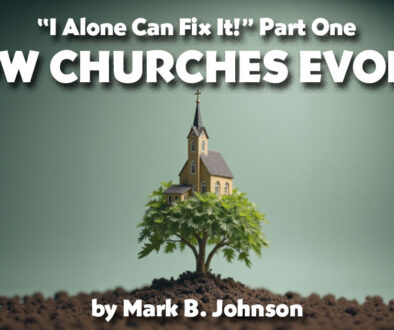Finding a Better Way to Select the General Conference President
by Edward Reifsnyder | 9 January 2024
I’ve never heard anyone say anything good about the way the Seventh-day Adventist Church selects the President of the General Conference (GC). Let’s be judgmental right up front, and affirm that the tithe-paying constituency should be comfortable with the process.
One conference president who has served on the GC Session Nominating Committee has commented that a lot more due diligence goes into selection of a local pastor than the GC President.
How does it work now?
A large bunch of people (some 2,000) show up at the GC Session. Pretty quickly, each Division’s delegation caucuses and selects ten percent of their delegates to be members of the Nominating Committee. The Divisions select those members “by the method of voting considered by each delegation to be most convenient and efficient.” (GC Constitution) The GC then adds another eight members. It all adds to roughly 250 members of the Nominating Committee.
Right off the bat, you can see there is room for mischief. Each Division’s option of using the “most convenient and efficient” method of voting can lead to anything and is subject to being manipulated by Divisional leaders.
Then these 250 people show up immediately in a room. The sitting GC President presides over the election of a Chairman for the Nominating Committee. The new Chairman then presides over the election of other helpers in the committee process – Vice chairs and Secretaries, etc.
Then they get down to the business of nominating the President of the General Conference. This seems to consist of committee members throwing names up on a board with ensuing discussions leading to a series of votes until someone is nominated.
How sophisticated is that process? Has any forethought gone into it? Probably the answer is “yes,” but likely not the right kind. Probably there has been – and is – all kinds of informal backroom politicking, negotiations, horse trading, and persuasion that is tragically non-transparent.
Some will say that God is leading in the process. Count me as a skeptic. Given the looseness of the process, I think it is all too vulnerable to the realities and foibles of humanity. My guess is that the current process is a throwback to the days when the Church was small and sited largely in the United States, days when everyone knew everyone.
Once the Committee’s machinations yield a name, the Chairman then dashes to the floor of the Session and interrupts whatever is happening to present the Committee’s nomination of one person to be President. The delegates then vote.
If the nomination is approved, the President-elect then meets with the Nominating Committee for the remainder of its work. Interestingly, in 2015 it took three ballots of the delegates to elect Ted Wilson. The first two ballots on the floor resulted in his nomination being referred back to the Nominating Committee. Quite unusual, and usually a sign of opposition. Both the Nominating Committee and the delegates were apparently somewhat insistent!
Above the surface, nothing happens toward the selection of a new President before the GC Session, unless you count the non-transparent stuff. There is no formal process to develop consensus on what type of leadership is needed for the next five years, no orderly process to identify qualified candidates, no consensus on what the world church wants from its next President, or what should be accomplished in his/her (right!) new term. Nothing. It just all happens in one messy blurt!
But, below the surface, who knows what happens? The absence of an orderly process creates opportunity for politicking, influence peddling, deal-making, and untoward exercise of power.
I’m sure there will be those who will say the Spirit leads in this non-system. Maybe. Maybe not. It all looks pretty human to me.
We need a better process!
Personally, I think what we do is appalling. It needs to be changed.
So, what if we did it this way?
- Independent, external, and highly qualified executive search consultants are retained to do groundwork in advance of the GC Session.
- The consultants interview a large number of key stakeholders, including all Division presidents, a sample of Union and Conference presidents from around the world, a few key GC leaders, and an equal sample of lay people.
- In the interviews, the following questions are asked:
- What does the Church need from its next President?
- What qualifications, temperament, characteristics, traits, attitudes, skills, and experiences would be ideal in the next President?
- What would you like to see the next GC President accomplish, with specificity, in the first two years in office?
- The consultants then prepare a summary document that compiles the views of all the interviewees. The document will then be approved by a small, carefully selected steering committee. The steering committee’s role is to review the document for reasonableness, but not to alter the views gathered from around the world. This document in essence describes the ideal candidate and his/her ideal impact on the Church.
- The consultants then solicit referrals of potential candidates from Divisions, unions, conferences, institutions, and membership. The consultants also solicit direct indications of interest from people who may wish to be considered. These referrals and indications of interest are handled with the greatest of confidentiality. During this phase of the search, the process becomes a black box.
- If the sitting GC President desires to be re-elected, he/she would be processed in exactly the same way as the other candidates.
- The search consultants then process the potential candidates, including preliminary screening and face-to-face interviews, to determine whether they meet the criteria laid out in the summary document and whether they are interested, and assess whether they possess the required experience and capabilities.
- The search consultants prepare a summary and an assessment of all the candidates and present them to the Nominating Committee at the beginning of the GC Session.
- The Nominating Committee then takes that information and does its work of selecting one or more names to present to the GC Session for voting.
The purpose of such a process is to identify the kind of leadership the Church at large believes it needs next. It handles all interested parties in exactly the same structured, objective fashion. It would hopefully eliminate the ad hoc politicking that we know goes on. It presents a carefully screened set of candidates to the Nominating Committee to begin their work instead of a random, haphazard process of throwing names at a board.
I think we can assume there is at least one person in this world who would not like the process outlined here. It is not very controllable. It is a black box until the first meeting of the Nominating Committee. Of course, this does not prevent people from politicking anyway, but that would at least be outside the process—it would not be the process.
What we have currently is a non-process that is the playground for ambition. It is wide open to manipulation and influence peddling.
We ought to have something better. We deserve something better.

Edward Reifsnyder is a healthcare consultant. He and his wife, Janelle, live in Fort Collins, Colorado.




